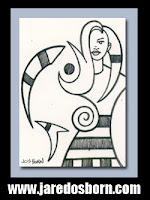
As I was reading the “Creepy Archives” volume one (haven’t posted the review yet though I loved it; go out and get your copy now) a thought struck me about the absolutely gorgeous art. “We don’t see comic art like this anymore”.
Styles in art and illustration come and go and every style is informed by the time and place around it thus making even comics draw today “dated” but this is a little different. This is something I hadn’t noticed before.
I had never read the issues of “Creepy” (1-5) reprinted in this archive. I am familiar with all of the artists involved, Reed Crandall, George Evans, Frank Frazetta, Gray Morrow, Angelo Torres, Al Williamson, plus a few others, but I hadn’t seen all of their work from this time period gathered together.
These are all artists who were working in a classical adventure comic strip style. This means that they relied on photo reference. They all had vast files of photos, books, and magazine clippings to see what something looked like if they were called upon to draw it. Or if they needed a picture of a character standing just so they would call on friends to pose for them and shoot it themselves. Not every panel would be photo referenced but some would.
For years the classical illustration type of photo referencing remained in comics but wasn’t the dominant style. Artists coming out of the Neal Adams school (not literally a school) were using photo reference to a degree but most comics were of the Jack Kirby or Steve Ditko school where things were mainly drawn from the imagination. That type of drawing dominated for twenty years or so and it’s still going strong.
In recent years photo referencing has made a big comeback. This is because of the advent of computers and digital photography making it easier than ever to take and manipulate photos. But there is a big difference. Instead of this photo referencing style being based on classical illustration it’s based on photo realism.
Photorealism is a fine art style that came alive in the late Sixties and early Seventies. It was all about using a photograph as a guide to make a painting. The end product was a painting that looked like a photograph. People would do a double take when they realized they were looking at a painting. These paintings are all about how the camera sees the world. That is different than how the human eye sees the world. The difference can be summed up by noticing that when people see a photorealistc painting they mistake it for a photo and not reality.
It is this photorealism that informs today’s photo referenced comic book art. The classical photo referenced illustration style never tried to make the reader think he was looking at a photo. The reader always knew he was looking at a drawing but it was sometimes photo referenced to make the world of the drawing as believable as possible. Most people would never even know that photo reference was involved.
What I also find interesting about this new photo referenced/photorealism phenomenon is that how the camera sees has become the new realistic. Lens flares are the most obvious example of this. A lens flare is when light hits a lens in just such a way as to make a hot spot. When looked at through a camera lens a piece of anything shiny can radiate light like the sun.
Photographers have worked for a hundred years to keep lens flares from ruining their pictures. But now on computer created art they are placed in to make things more “realistic”. Ten years ago when computer coloring first hit comics there were lens flares on everything. It made the drawings more “realistic”. Things have died down on that front but in video games the lens flare is alive and well.
“How the camera sees” is the new realistic in 3D video games not “How the eye sees”. I find it distracting and unrealistic but game makers don’t. Lens flares during a dramatic moment as a bright light shines in your character’s eyes are the norm now in video games. It ruins the realism for me because I know that, in reality, you need a lens to have a lens flare thus in that moment of the game I no longer feel I’m immersed in playing the game but merely watching it through a camera.
Which brings us back to comics and photo referenced/photorealism. Some guys do it well and some don’t. The guys who don’t are the ones who always remind me that I’m looking at a photo based work. At least they’ve laid off the lens flares in comics. No if only some of them would go back and look at how the old guys used to use photo reference. They might get some good ideas.
Thanks!
Excellent piece!